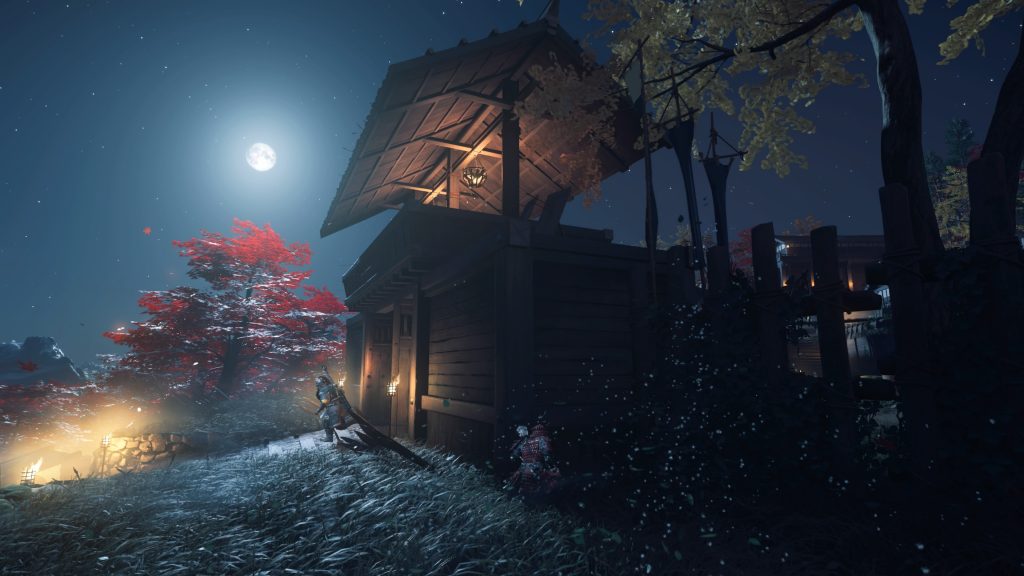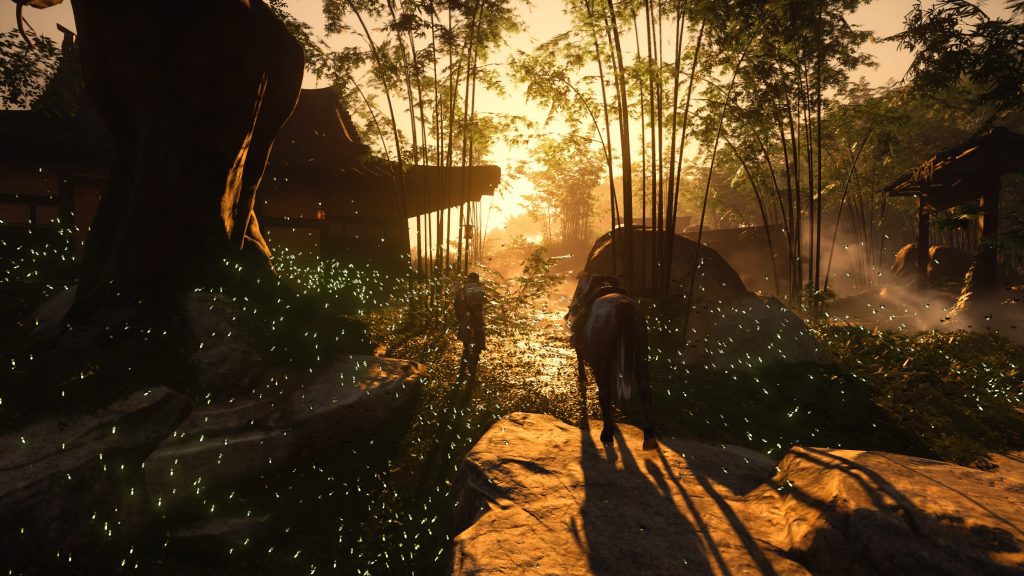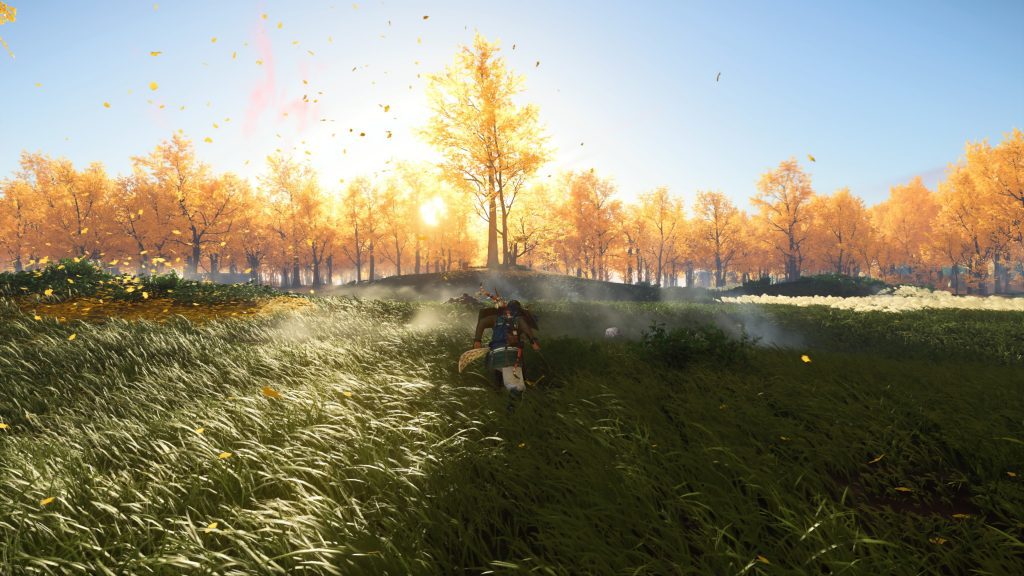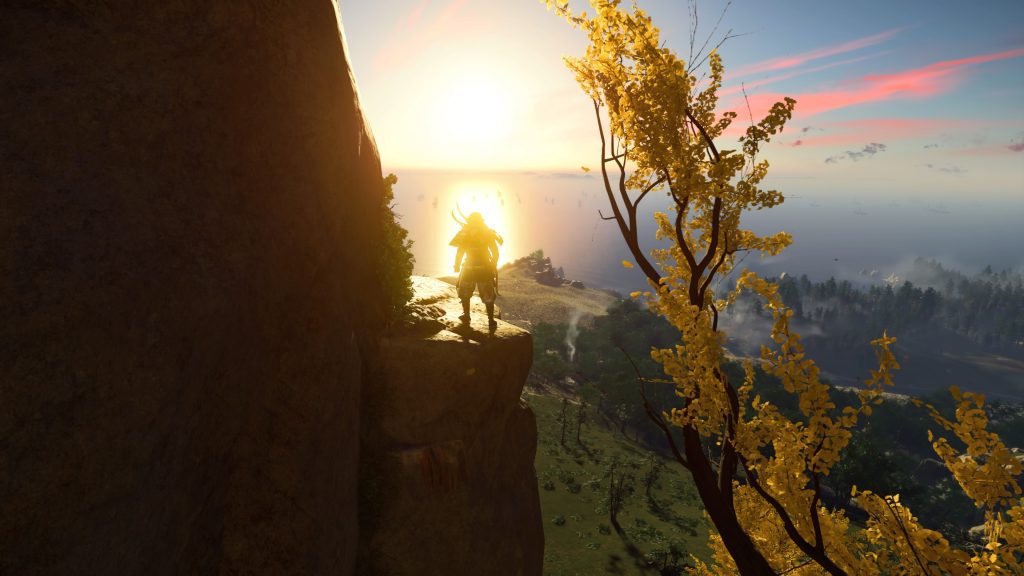
Review Copy provided by Sony. Reviewed on PS4 Pro.
Ghost of Tsushima arrives at a turning point in the generational cycle. As the last major first-party release on PS4, it’s worth hoping for something truly great to bring this unusual console generation to a close. If done right, a title like Ghost of Tsushima could achieve for developer Sucker Punch Productions what Horizon Zero Dawn did for Guerilla Games: cementing their commercial and critical success while moving the studio into next-gen with a successful new IP. After all, Sucker Punch and Guerilla were in similar situations at the start of the generation. Neither Killzone Shadow Fall nor Infamous Second Son matched the quality of previous entries in their respective series, and it was time for both studios to try something new.
Unfortunately, Sucker Punch’s final product is less impressive. Ghost of Tsushima is an enjoyable but muddled experience: its strong gameplay fundamentals are hampered by weak storytelling and a lack of originality. There’s much to enjoy in Ghost of Tsushima: the combat is fluid and engaging, the world is stunningly detailed, and it’s a joy to navigate. But it suffers from a clichéd narrative filled with forgettable characters, and the kind of open-world padding that’s likely to drive completionists mad.
If Ghost of Tsushima has one major advantage, it’s that its gameplay fundamentals are incredibly strong. Lead character Jin Sakai’s horse controls are fluid and make riding a pleasure. Headshots with the bow and arrow feel satisfying, and there’s a good variety of combat and stealth tools, ranging from bombs that stun enemies to wind chimes that distract them.

The game is chock full of RPG elements, from a reputation system that levels up as missions are completed, rewarding Jin with stats boosts and ability unlocks, to a skill tree. Luckily, it’s all handled well. New skills and tree branches are well-thought-out and suit the various styles of play the game encourages. There’s a number of gear and armor upgrades, both cosmetic and functional, and players are incentivized to swap them out to meet the needs of the encounter.
A solid foundation goes a long way, and though my frustrations with Ghost of Tsushima are many, they never outweigh the sheer fun of scaling cliff faces, assassinating Mongol goons from the shadows, or clashing swords in a duel. Each blow in battle feels impactful, and the flow of combat is just right. Sucker Punch have managed to strike a brilliant balance between aggression and defense, and when battles hit their stride, the ballet can be extraordinary.

Enemies in Ghost of Tsushima don’t have much health and can usually be killed in a few blows, but they hit hard and can take Jin out just as fast. Combat is complemented by a stagger system that allows the player to break the enemy’s guard and a stance system that changes Jin’s techniques to battle more effectively against other enemy types.
These encounters can throw large numbers of enemies at the player, although they’re broken up by one-on-one duels that function as boss fights. They’re handled well, neither too frequent nor infrequent, presenting interesting, difficult challenges that require a keen eye for enemy movement. In most encounters, the stealth approach is preferable, if only to whittle enemy numbers down before confronting the rest in a stand-off. Clearing out enemy camps remains satisfying, even when the quest design and enemy AI disappoint.
Rather than following the more freeform approach found in games like Metal Gear Solid V, Ghost of Tsushima takes a page from Red Dead Redemption 2’s book. In story quests, if you deviate from the exact path the game wants you to follow, you trigger a fail state. At one point, I simply wanted to loot a few items from a building a few steps away from me during a quest, but when I entered it, a large “Return to Tale Area” message flashed on the screen and forced me back to the last checkpoint. It’s unfortunate that a game with such a focus on exploration would railroad the player down such a narrow, restrictive path during its main missions.
Unfortunately, Ghost of Tsushima suffers from the open-world bloat syndrome that drags down many open worlds. The map is cluttered with quests and activities that range from enjoyable to tedious. The most enjoyable use of environmental elements to guide the player to a hidden upgrade. There are shrines with broken pathways that require Uncharted-Esque climbing and platforming to reach or dens where foxes will lead you to a small shrine that opens Jin’s accessory slots. Less enjoyable are the endless enemy camps scattered across the world that, when cleared, reveal the current region of Jin’s map. That’s a helpful reward, but the camps themselves are samey and unremarkable.

Ghost of Tsushima’s side quests leaves something to be desired. Most of them revolve around the same basic “go here and kill this” schematic, without much in the way of interesting side-characters or stories. These side quests often contain short cutscenes at the beginning and end, but these conversations are unusually framed. They almost always use long, zoomed-out shots, perhaps to disguise a lower quality of facial animations. While the side quests are entirely optional, a number of them contain useful upgrades that make them worth the tedium.
Before Ghost of Tsushima’s release, much was made about its supposed lack of waypoints. The game promised a more naturalistic, environmental approach to navigating and exploring this world. For whatever reason, this isn’t really the case with the final product. The game is full of waypoints and map markers for quests. There’s also the Guiding Wind, a system that points the way to your next map marker with the direction of the wind. It sounds interesting in theory, but in practice, it’s nearly identical to any other compass system. Those expecting the open-ended exploration found in games like The Legend of Zelda: Breath of the Wild won’t find it here. Sucker Punch’s world has much more in common with the approach taken by recent entries in the Assassin’s Creed franchise.
Ghost of Tsushima is supposedly set in 1274 on Japan’s Tsushima Island. Although, it’s not really 1274 and this isn’t really Tsushima, but I’ll return to that point. Our hero Jin is a respected Samurai warrior and heir to the Sakai clan, raised by his uncle, the mighty Lord Shimura since the tragic early death of his father. When the Mongol empire invades Japan, most of the samurai are slaughtered in a massive battle with the Khan empire’s forces. Struck down on the battlefield in the midst of all the chaos, Jin’s life is saved by a woman named Yuna, who leads him down a path of guerilla resistance to the Khan army that runs counter to the code he’d followed for many years.

It’s dangerous to namedrop Kurosawa, yet Ghost of Tsushima wears that influence on its sleeve. The game is littered with direct and indirect references to that great director. Upon starting the game, the player is asked if they’d like to engage “Kurosawa mode.” Yet the Kurosawa influence doesn’t extend past aesthetics. Ghost of Tsushima has more in common with Zack Snyder’s 300 than any film Kurosawa made.
Toward the end of his career, in magnificent films like Ran and Kagemusha, Kurosawa was introspective and self-critical. Those films, especially Kagemusha, suggest that the Samurai, rather than an infallible hero, was an icon weaponized as imperial propaganda. That level of nuance and depth of understanding is nowhere to be found in Ghost of Tsushima, which is more of a Samurai-themed action flick.
It doesn’t appear to have anything interesting to say about ancient Japan, the culture of Samurai warriors, or the Mongol invasion. The Mongol baddies are entirely dehumanized, comically evil villains with little depth, and Jin is entirely noble and heroic, despite his extreme methods. There are the occasional story and dialogue choices, but I never really felt their consequences shape this world.
It’s supposed to be rooted in fact and history, but in reality, the game world is a heavily fictionalized, nonspecific collage of locations from across Japan. In a PlayStation Blog post, Sony described the world as containing “essential elements of the island, mixed with some inspirations from mainland Japan.” The timeline isn’t right either, as there’s a number of anachronisms for 1274. Taking liberties with history isn’t always an issue if it serves a larger purpose, but it’s hard to figure out the point of creating a mashup of various locations across Japan rather than actually basing the game map on the island it’s supposedly set in. The end result is a very American take on ancient Japan, the chronology and geography all mixed-up.

Of course, Ghost of Tsushima doesn’t need to be groundbreaking if it works as an engaging piece of entertainment. But even on that level, the narrative is baggy. Our lead, Jin Sakai, is a strangely flat character, and I was never really drawn into his personal story. His tale is driven forward by the moral conflict between the code of honor espoused by Jin’s uncle, and the more pragmatic, by-any-means-necessary tactics Jin and Yuna eventually adopt. But that conflict isn’t that interesting: it mostly boils down to a cipher for the same old chorus of cliches about honor, glory, and the code of the samurai. What twists and turns the story does have are predictable and usually telegraphed a mile away. It all culminates in a conclusion that’s surprisingly anticlimactic.
Ghost of Tsushima does have one of the most visually arresting worlds I’ve seen in a game. Sucker Punch have done an exceptional job creating a completely authentic sense of natural beauty. From dense bamboo forests to serene grasslands, nearly every environment here is spectacular to look at and a pleasure to navigate. It’s worth calling attention to the game’s excellent lighting system, which produces convincing results perfectly well-suited to each area of the island. Ghost of Tsushima features a complicated day and night cycle, and it was always a treat approaching quests at the golden hour and taking a few moments to marvel at the sheer beauty of it all or snap a few shots with the fantastically feature-rich photo mode. I only noticed a few rare drops in the frame rate on my PS4 Pro, but nothing that significantly affected the experience.
The animations are more of a mixed bag. I can forgive Sucker Punch for prioritizing smooth, responsive controls over more realistic animation work. But in story sequences, the facial animations are unusually stiff and the lip-sync feels off. I started my playthrough with the Japanese voice track and English subtitles, but the lip-sync felt wrong, so I switched over to English, only to realize that the English dub isn’t much better. This isn’t the fault of the actors, of course, who make the best of the material they’re given.
One area I can praise without caveats is the sound work. It was a brilliant decision to hire Shigeru Umebayashi, the acclaimed composer known for his work with Wong Kar-wai on stellar films like In The Mood for Love and 2046. His work with fellow composer Ilan Eshkeri fills the world of Tsushima with a sweeping, magnificent selection of tracks that always seem to complement the mood. The game’s sound design is top-notch. Especially worthy of praise is its 3D Audio implementation for headphones, which accurately maps every evening breeze or clang of swords to produce its proper sense of place.
There’s plenty to admire about Ghost of Tsushima, but those qualities are tempered by the game’s disappointments. Its weak story and flat characters struggle to maintain interest, while the game falls into many of the same trappings that plague the open-world genre. Yet it’s carried by great gameplay fundamentals. The controls are snappy, the combat is thrilling, and the visual spectacle is extraordinary. Despite everything else, Ghost of Tsushima is just fun. But it’s not much more than that.
